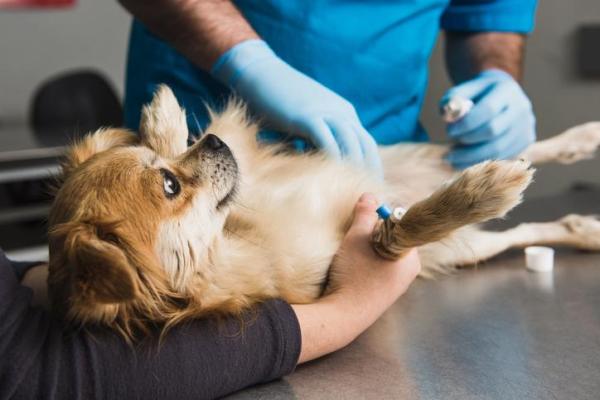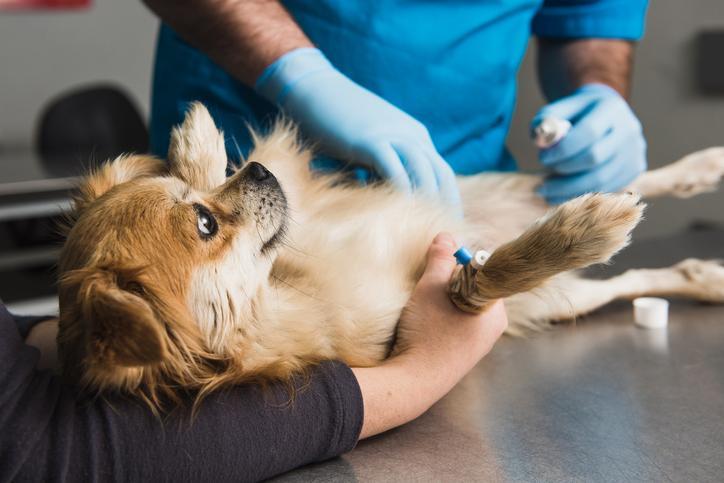Metritis in Dogs - Uterine Infection Causes & Treatment



See files for Dogs
Metritis is something which can only happen to female dogs. This is because it is an infection of the uterus. A bacterial infection, it occurs during birthing or shortly thereafter. There are different causes of metritis, as we will see further on in this AnimalWised article. While we should be ensuring the health of a pregnant dog at all times, we need to be particularly careful during and after labor in case any complications arise. The postpartum period is also very important to ensure the health of both mother and puppies.
As we look at the causes, symptoms and treatment of metritis in dogs, we can better understand canine uterine infection in general. The first thing to know is that, if metritis in your dog is suspected, you will need to go to the veterinarian immediately. If treatment is not instigated the results can be fatal.
What is metritis in dogs?
Uterine infections in dogs are very serious medical issues which can affect different parts of the uterus. Metritis, as with all diseases ending in -itis, is a type of inflammation. Endometritis is a related condition which affects the uterine lining, the endometrium. Metritis specifically refers to an inflammation of the wall of the uterus, but it is possible for the two to occur together.
In female dogs, metritis stems from bacteria which manage to ascend from the vagina into the uterus. An infection is triggered which results in inflammation. The most frequent causes of the disease are those which allow bacterial overgrowth, often in the environment of where the dog is living. This exposes the dog to bacteria and leads to infection.
As parturition (giving birth) opens up the vagina, bacteria are given greater opportunity to enter the uterus. For this reason, the disease is often referred to as postpartum metritis. We need to be very careful during this time to monitor for signs of its presence.
There are also some specific reasons why metritis may develop, most often related to birthing complications. Not all of them may be observable initially, but they include:
- Retained placenta, either still attached to the uterus or not being birthed with the embryos.
- Mummification of one or more fetuses.
- Contamination of the birth canal both during and after delivery.
- Lack of hygiene of the birth location.
- The placenta is not removed from the birth location if the dog does not ingest it.
- Dirty blankets or other material are not removed after parturition.
Symptoms of metritis in female dogs
Since we may not be able to see that any of the above causes have happened, we need to look at the symptoms of metritis in dogs. These symptoms can begin to present between 2 and 7 days after the birth has taken place. The following signs should make us suspect a uterine infection may be taking place:
- Lethargy
- Anorexia
- Rise in body temperature
- Fever
- Stop caring for puppies
- Vomiting
- Diarrhea
- Abnormal vaginal discharge
- Foul smelling odor
- increased thirst
There should be some discharge which encapsulates the placenta and any other afterbirth material (lochia). However, if this discharge is foul smelling or noticeably purulent, then there is a clear sign of infection.
Although all the above signs are serious, if we observe brown vaginal discharge, we may be presented with acute metritis. If this is the case, veterinary advice needs to be sought immediately. The dog will have a natural inclination to lick itself to remove any fluid or afterbirth. For this reason, it is important to monitor the birth so we can see any abnormality before the evidence is removed. As we state above, metritis and its symptoms can appear after delivery of the puppies.

Treatment for metritis in dogs
The veterinarian should immediately check if a female dog has symptoms such as those described. By performing a palpation on the abdomen of the dog, the vet can first see if there is any abnormal inflammation. If this diagnostic test is inconclusive, they will perform an ultrasound to check for evidence of either placental or fetal retention.
Ideally, the veterinarian will be able to take a biopsy of the uterus to determine which type of bacteria is causing the uterine infection. The main reason for this is so that they will know the best type of antibiotic treatment to administer for treatment. Given the severity of this infection, the speed with which the bacteria can spread and its potential lethality, antibiotic treatment is usually administered intravenously.
For this reason and more, it will be necessary for your dog to go into a veterinary clinic or hospital with the correct equipment available. The dog may also need additional treatments such as fluid therapy. Hormone treatment with oxytocin or prostaglandins may be used to empty the uterus. Occasionally, the veterinarian may also irrigate the uterus directly with saline solution or disinfectant. In the most severe cases, surgery to remove the ovaries and uterus (ovariohysterectomy) may be required. This is likely a life or death operation.
After recovery, some bitches may have a mild persistent inflammation of the uterine lining (endometritis). In these cases spaying is recommended, although spaying may be a good idea in general. Another pregnancy may have similar complications which can put the dog's life at risk again.

What happens to puppies of bitches with metritis?
In the most severe cases of metritis in female dogs, they will be too sick to take care of their puppies. When this occurs, we will need to take over rearing of the puppies. The first step is to ensure they are fed, meaning we will need to purchase some newborn puppy formula. This emergency homemade formula can be used until this becomes available. We will also need to help ensure the area is clean and they are kept sufficiently warm.
As soon as possible, take the newborn puppies to the veterinarian. They will be able to examine the puppies for their own signs of illness and provide practical advice to help you care for them. Here are some additional resources to help you know what to expect:
Prevention of metritis in dogs
Understanding how metritis is triggered in female dogs will help us to prevent this type of inflammation. A good measure is for the veterinarian to examine the dog approximately 24 hours after the initial delivery. In doing so, the vet can help empty the uterus if necessary and reduce the chances of a uterine infection being triggered in the first place.
Another good idea is to take the dog's temperature once a day after delivery. A rectal thermometer will have to be introduced gently. A temperature rise indicates that an infection is present, so a high reading should be addressed by taking the dog to the veterinarian. This is important as it is essential to treat metritis quickly.
Although the above measures allow the fast detection of metritis, the most effective way to prevent metritis is spaying. A neutered cat with its uterus removed cannot get a uterine infection, unless a uterine stump is left after surgery. In these cases, other uterine infections such as pyometra can be present. Neutering also helps to prevent the birth of unwanted puppies and can help ensure the overall health of the dog.

This article is purely informative. AnimalWised does not have the authority to prescribe any veterinary treatment or create a diagnosis. We invite you to take your pet to the veterinarian if they are suffering from any condition or pain.
If you want to read similar articles to Metritis in Dogs - Uterine Infection Causes & Treatment, we recommend you visit our Infectious diseases category.
- Carlson, D. G., et al. (2007). Dog Owner's Home Veterinary Handbook. London: Howell Book House.
https://www.amazon.com/Dog-Owners-Home-Veterinary-Handbook/dp/0470067853







